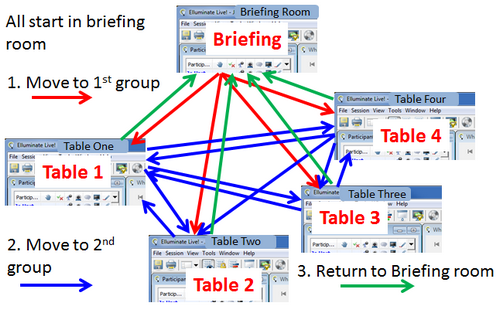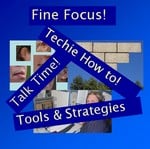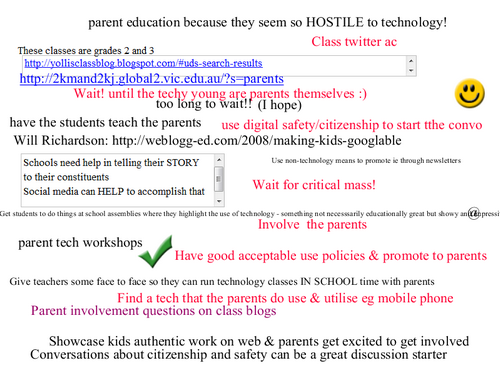Background
A couple of weeks ago I was part of an incredibly exciting event here in Western Australia. The Federal Government, through the Department of Education, Employment and Workplace Relations (DEEWR), is in the throes of developing a new National Foundation Skills Strategy for Australia. Part of the public consultation process for this has been a series of focus groups around the country in major cities and some regional centres. These have been run on a “World Café” model with participants in small groups re-mixed several times.
Because Western Australia has huge issues around geographical isolation the forward thinking Literacy people from the Department of Training and Workforce Development suggested a variation to the process that would enable regional participation. The suggestion was that an Elluminate virtual room would be a possible solution! I teach literacy/numeracy and I currently deliver entirely online using Elluminate as a major component of my blend. Because of this our State Literacy experts knew of my Elluminate experience and asked me both to advise on the best way to do this and to be the primary Elluminate moderator for the whole process.
From the moment I was asked for my input I was completely ”hooked”. It was a challenge, and an opportunity to show what is possible with Elluminate. Incidentally throughout the whole planning process I didn’t meet “face to face” with anyone else involved in planning the event. About 90% of communication was through email with around three medium length phone calls and an Elluminate meeting.
What I am giving here is the whole process from my perspective. It can’t be over-emphasised how much it was a team effort. It would not have been possible without: the vision and drive of the literacy experts from the Dept. of Training and Workforce Development; the superb moderators who managed the discussion rooms; and the continuing support throughout from the Sector Capability people at WestOne.
Planning
This post is a “window” on the possiblities, outcomes and the event itself from my perspective as the Elluminate adviser and primary moderator.
The requirement was:
- a place for everyone to be together for a briefing and for the final activities in the process
- four to five “tables” depending on number of participants
- the capacity for groups to remix 2-3 times
Maybe the initial first reaction from most people would be breakout rooms – however I will now duck for cover and say that was definitely not my first thought! Yes, I have used them but I am not a great breakout room fan. They are excellent if you want to use one or two. For example with two lecturers online with our students we have a breakout room where one of us can work with a single student. However disadvantages experienced include the following:
- time consuming to access and move between – especially for inexperienced participants as moderators have to do the moving in this situation;
- not (as far as I am aware) included in the recording if the main room is being recorded;
- from my own experience, apparently heavier in terms of bandwidth, as greater dropout and other issues such as lag experienced when breakout rooms are in use, particularly when participants may have slow connections.
The last of these is particularly relevant to our context in regional Western Australia. We regularly experience poor connection speed/low bandwidth despite our supposed broadband connections. Although Elluminate generally works very well in these conditions it behoves us to avoid the higher bandwidth options where possible.
Having instantly dismissed breakout rooms because of our regional/connection issues the obvious and logical option seemed to be several separate Elluminate rooms. As I write this I can visualise people throwing up their hands in horror at the logistical issues and indeed my first thought was – how could that possibly be managed to ensure that people move to the correct rooms to remix and balance numbers at each change.
The idea of several rooms was greeted positively so this was planned along the following lines:
- one Briefing Room where everyone would come together before moving to the other rooms
- four to five rooms designated as “Discussion Tables” each facilitiated by a moderator.
The participants would then move and remix between the “Discussion Tables” as necessary.

So planning progressed with the initial thought being to pre-arrange the groups and send each person the links they would need. Even as I was saying this my inner self was saying No! No! This will be a disaster! In my experience if you send people more than one Elluminate link in an email there is a high risk that 10-20% will click on the wrong one at some point. After further thought I came up with the solution that we adopted. This was to have whiteboards in the rooms at each group remix/changeover point. These would have participant names grouped with a live link for them to use to move to their next room. There was an additional advantage in this as it enabled us to rearrange groups at the last moment to compensate for any non-attendees. We would then ask participants to enter their next room and afterwards to exit the one they were leaving.
The next challenge to the Elluminate environment was the final activities. In the “real” (face-to-face) meetings these activities are comprised of 8 questions posted around the physical room with participants moving around the questions and adding short responses/comments/ideas on post-it notes. The solution was to use whiteboard roaming enabling all participants to roam the whiteboards and add their responses to each question. The “Discussion Table” moderators each monitored two questions in order to organise the contributions and add extra whiteboards as needed.
Once the structure of the event was finalised and agreed by the consultants I produced a timetable and briefing sheet for moderators describing the process. The next step was a meeting in the “Briefing Room” on the Thursday evening before the Friday morning of the event, this was an opportunity: for our State Literacy experts to brief all of us on the consultation; for the consultants carrying out the process to have an introduction to Elluminate and indicate any changes they wanted made to the way we had set everything up; and for a moderator briefing and opportunity for questions and clarification. This session was scary as one of the moderators was suffering from a very poor connection and was unable to hear most of the conversation due to audio lag and drop-out. I spoke to her by phone afterwards to catch her up on what had been discussed. I think all of us had (hopefully, well concealed) nerves that one of us would have an issue on the Friday morning.
Risks and contingencies
We tried to risk manage and contingency plan as far as possible for any issues arising. The most likely being connection issues for myself as I planned to have all five rooms open simultaneously allowing me to quickly respond to problems; connection issues for the other moderators; connection issues for participants; equipment problems for anyone; possible problems with people moving between rooms. We put in place several strategies to try to mitigate these issues should they arise:
1. I planned to remain in the Briefing Room throughout
- all participants had that link and so could easily return there if they had a problem
- moderators were asked to keep their Briefing Room link live throughout if possible so that they could text me there if they hit problems
- moderators were alerted to email me – or tweet if they encountered problems and they couldn’t contact me via the briefing room
2. Monitoring arrival in rooms so that:
- if participants did not leave their previous room themselves we could remove them easily to reduce confusion and pressure on their connection
- if anyone went to the wrong room we could alert them and give them the correct link
3. Monitoring all rooms myself as far as feasible to enable me to:
- join and help more quickly if any issues arose and specifically to take over if a moderator lost connection
- remind moderators when session changes were due
4. Giving the “table” moderators a fairly detailed timetable of what they needed to do and when with an overview briefing to flesh this out prior to the virtual briefing session the evening before the event
5. Pre-preparing as much as possible in advance including setting up and converting all the slides to whiteboards beforehand so that I was able to load them quickly and easily into the relevant rooms.
The event
The whole event passed off very smoothly – to my great relief! We had a couple of minor issues that were overcome thanks to the contingency planning. One participant was unable to access her next room from her current one by clicking the link on the whiteboard, but was able to copy the link, leave the room and then join the next room. I think this may have been a bandwidth issue. When providing the link in text for this participant in the first instance I inadvertently gave her my moderator link for the room instead of the participant link, however this was quickly rectified. Another participant accidentally went to the wrong room on one occasion but moved quickly and easily to the correct one once given the link in text. One room moderator had a microphone failure and had to get a new headset. I saw this and returned to her room. The participants didn’t need me except to add a whiteboard – they already had an established conversation process by then.
My connection held up well and I had no problems with maintaining all five rooms open for the duration of the event.

Having five rooms open to monitor at the same time was logistically very interesting – I have only ever previously been in two simultaneously! Incidentally I don’t think it would have been possible without two screens. How I managed the multi room scenario is as follows:
- Opened the briefing room and loaded slides
- Opened each of the four “table” rooms successively, and for each room, loaded slides, moved speaker slider to minimum and put myself to “Away” before moving on to open the next room and do the same there.
- I routinely work in Elluminate with unlocked windows as I prefer a large chat window and I think an unlocked format was essential for me in this event enabling me to change window sizes at need
- I didn’t use docking and minimising to manage the rooms, instead I reduced the Elluminate window width – this enabled me to quickly see the current whiteboard in any room by simply widening the window
- I lined up the “table rooms” from one to four left to right on my secondary (left hand) screen and used the full primary (right hand screen) for the briefing room
- I was in the briefing room early and as participants logged in I reminded them to check their audio and also chatted to break the ice and ensure that everyone was comfortable with the environment
- Then I remained “in” the briefing room throughout
- When I needed to communicate to room moderators I did so through private message text in their room – this was mainly time reminders to ensure that the room changes were all occurring at about the same time.
What went well
The short answer is everything! However there were some aspects where I was particularly apprehensive of issues and where the reality far exceded my hopes!
- Using five separate rooms instead of breakout rooms gave an outstandingly better experience for everyone
- The room change arrangement worked exceptionally well, using a single whiteboard for each change with participant names associated in a group with a live link was far more successful than trying to send out links in advance
- Using participant roaming through the whiteboards for the final “post-it note” activity seemed to mimic the face to face scenario far better than I had anticipated
- Having five “live” rooms open simultaneously was far less problematic than I had feared.
Improvements for the future
As is always the case one of the most important parts of using any innovative strategy is to identify how it could be done better next time. These are my own particular areas for improvement:
- Set up room timers with a name – I had four live timers on my screen at times and I couldn’t easily tell which one belonged to which room
- Ensure that participants know that the room name is at the top of the window on the “frame” – I had a comment from a participant that she hadn’t known that and that when she realised it all became much easier
- Add to the moderator briefing to the effect that the primary moderator will remind just before room changes – I hadn’t warned the moderators that I would do this
- Organise my list of links better with more space between them and better labels to ensure I don’t choose the wrong one to pass on to someone else.
Aftermath
We have had many positive comments both from participants and from the consultants. The amount of data gathered is very large with numerous whiteboards and much text input as well as the recorded discussions on audio from each individual “table”. Using these multiple inputs has given the data a high level of “richness” as everything is captured. This is different from the usual face to face situation where discussion round a physical table is usually captured only sparsely through outcome notes on paper. Another advantage of the online environment for this type of consultation is that there may be several discussions going on around the same table using the different media so more ideas can be exchanged in the same time period.
This is the first time that Elluminate has been used in this way here in Western Australia or indeed we believe Australia wide. I have also never seen any mention of it being used in this way globally and would love to compare notes with anyone who has done anything similar to this.
I found the whole process and the event itself incredibly exciting and can’t wait for the next opportunity to be involved in a complex Elluminate situation.
 Those of us who took part in the consultation felt that using Elluminate enabled us to overcome Western Australia’s tyranny of distance and thus play a significant role in that consultation process.
Those of us who took part in the consultation felt that using Elluminate enabled us to overcome Western Australia’s tyranny of distance and thus play a significant role in that consultation process. Our next Webinar is an Edublogs “Fine Focus” session, “Facebook won’t go away!” I take a look at Facebook – from the premise that if it won’t go away (and it won’t) we need to embrace it as a tool. Join us on Thursday November 3rd at 23:00 GMT/UTC the time for you will vary depending on your timezone (check yours here) Thursday afternoon/evening in the USA, late night Thursday in Europe, and Friday morning October 4th in Australia – in the usual virtual room
Our next Webinar is an Edublogs “Fine Focus” session, “Facebook won’t go away!” I take a look at Facebook – from the premise that if it won’t go away (and it won’t) we need to embrace it as a tool. Join us on Thursday November 3rd at 23:00 GMT/UTC the time for you will vary depending on your timezone (check yours here) Thursday afternoon/evening in the USA, late night Thursday in Europe, and Friday morning October 4th in Australia – in the usual virtual room



